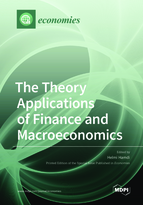The Theory Applications of Finance and Macroeconomics
A special issue of Economies (ISSN 2227-7099).
Deadline for manuscript submissions: closed (30 January 2021) | Viewed by 77561
Special Issue Editor
Interests: economics of banking and finance; energy economics; emerging market economies; macro-econometrics; financial stability; fintech and payment systems
Special Issues, Collections and Topics in MDPI journals
Special Issue Information
Dear Colleagues,
Recently, the world economy has witnessed some turbulences and instability that have raised concerns and added threats to the global economy. For example, climate change, trade war, regional political tension, Brexit and, the very recent Coronavirus epidemic that have hit several countries across all continents at an astonishing rate are among some of the factors that have increased uncertainty. We have also noticed the surge of technological innovations and their implications in the banking and financial sectors. Today, we talk about blockchain, fintech, insurtech, regtech, and big tech, which have changed the business model of banks, financial institutions, and also the management model of firms and public administration. To get better insight into all these trends, economists have used the finance and macroeconomic theory to analyze the micro- and macroeconomic consequences of all these events and to study their impacts on economic and financial sector stability as well as economic development and growth. In this Special Issue, Economies is inviting researchers and academicians to submit their work to a Special Issue dedicated to “The Theory Applications of Finance and Macroeconomics”. Some of the topics that contributions to the issue might address include trade tension, climate change, blockchain and cryptocurrencies, financial liberalization, macroeconomic issue, principles of international finance, and open economy macroeconomics.
Dr. Helmi Hamdi
Guest Editor
Manuscript Submission Information
Manuscripts should be submitted online at www.mdpi.com by registering and logging in to this website. Once you are registered, click here to go to the submission form. Manuscripts can be submitted until the deadline. All submissions that pass pre-check are peer-reviewed. Accepted papers will be published continuously in the journal (as soon as accepted) and will be listed together on the special issue website. Research articles, review articles as well as short communications are invited. For planned papers, a title and short abstract (about 100 words) can be sent to the Editorial Office for announcement on this website.
Submitted manuscripts should not have been published previously, nor be under consideration for publication elsewhere (except conference proceedings papers). All manuscripts are thoroughly refereed through a single-blind peer-review process. A guide for authors and other relevant information for submission of manuscripts is available on the Instructions for Authors page. Economies is an international peer-reviewed open access monthly journal published by MDPI.
Please visit the Instructions for Authors page before submitting a manuscript. The Article Processing Charge (APC) for publication in this open access journal is 1800 CHF (Swiss Francs). Submitted papers should be well formatted and use good English. Authors may use MDPI's English editing service prior to publication or during author revisions.
Keywords
- Economic instability
- Macroeconomic theory
- Theory of Finance
- Fintech, blockchain and cryptocurrencies
- Environmental degradation
- Trade tensions
- International finance
- Open macroeconomics






